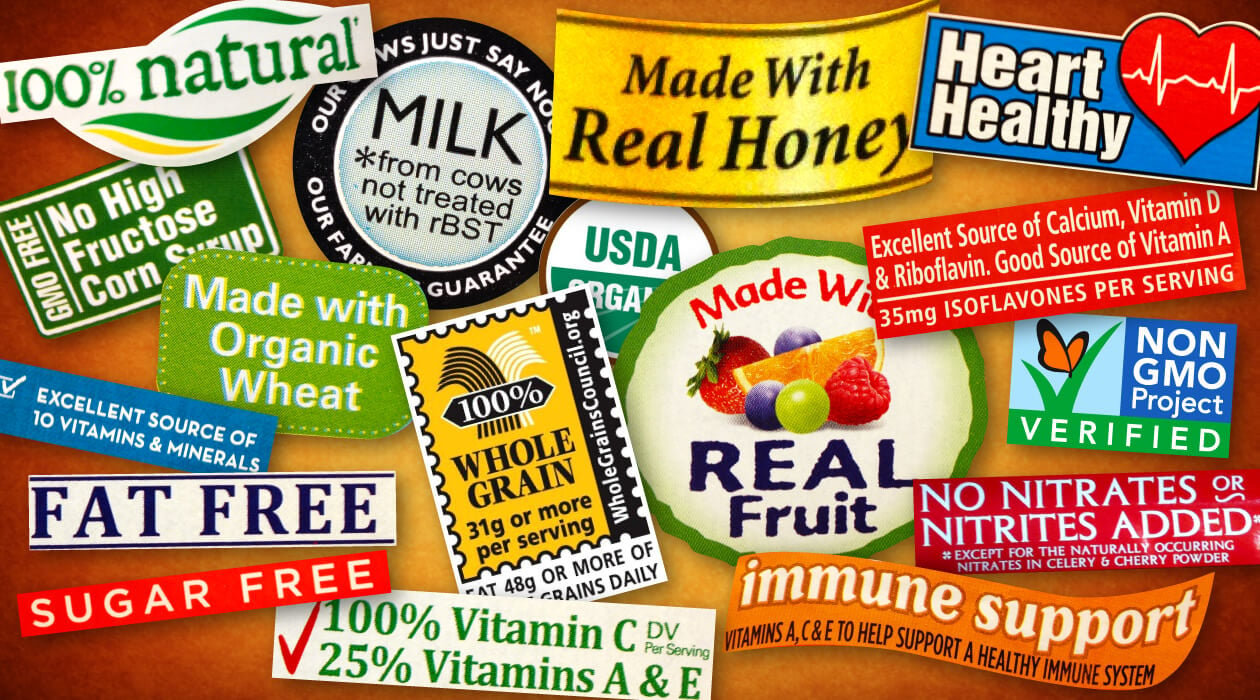Food labels tell you what there is for nutrition in each food item you buy. It will help you buy healthier foods, and lead a healthier lifestyle.
| Nutrition Facts | |
|
Serving Size 1 cup Servings Per Container 2 | |
| Calories 200 | Calories from Fat 110 |
| Amount/Serving | %Daily Value |
| Total Fat 12g | 18% |
| Saturated Fat 4g | 16% |
| Trans Fat 5g | |
| Polyunsaturated Fat 2.5g | |
| Monounsaturated Fat 9g | |
| Cholesterol 30mg | 10% |
| Sodium 50mg | 2% |
| Total Carbohydrate 7g | 3% |
| Dietary Fiber 2g | 8% |
| Total Sugars 1g | |
| Incl. 0g Added Sugars | 0% |
| Protein 5g | 6% |
| Vitamin A | 4% |
| Vitamin C | 2% |
| Calcium | 20% |
| Iron | 4% |
| *Percent Daily Values are based on 2,000 calorie diet. Your Daily Values may be higher or lower depending on your calorie needs. | Calories: 2,000 2,500 |
| Total Fat Sat Fat Cholesterol Sodium Total Carbohydrate Dietary Fiber | Less than 65g 80g Less than 20g 25g Less than 300mg 300mg Less than 2,400mg 2,400mg 300g 375g 25g 30g |

SIMPLE STEPS FOR READING A FOOD LABEL
1)Check the serving size, as many food items you buy will be more than 1 serving. If the food you choose has 2 servings, and you consume everything that is in the package, then you are consuming double of each item listed on the label.
2) Look at calories/serving and calories from fat/serving , as this tells you how much energy you get from the package. Least ignored. Not all calories are created equal.
3) The nutrients listed first are nutrients that are typically eaten in adequate amounts, often overconsumed in a Western diet. They are total fat, cholesterol, and sodium.
4) The next group of nutrients are not typically consumed enough, in the Western diet because of all the highly processed, convenience foods. Those are: dietary fiber, vitamin A ( which is an antioxidant), vitamin C, calcium, iron, and dietary fiber, to name a few. Some other vitamins you may see are vitamin D, vitamin E, Magnesium (which is part of over 300 reactions in the body), riboflavin, and potassium
5) The Footnote, which is on the bottom of the nutrition facts label. This shows the percent needed on a 2,000 calorie diet, and 2,500 calorie diet, according to the FDA. (3)
*In attempts to make food seem healthier, some food manufacturers decrease serving size.
*Daily needs are different, depending on your activity level
*Unsat- plant based
*Avoid non fats or low fat products as manufacturers use added sugar or salt to compensate
*Natural nutrients, but some are synthetic
NOT ON A FOOD LABEL
-%DV of only 4 nutrients, even though the body needs many others
-Doesn’t distinguish btwn synthetic nutrients and naturally occurring nutrients
-Doesn’t distinguish between complex and simple sugars
-Doesn’t include unsaturated fat
-Doesn’t distinguish between HDL and LDL cholesterol
-Doesn’t say if the product has been genetically modified, or how it was processed or refined
-Doesn’t say if there are pesticides, herbicides, heavy metals, or toxic minerals
DETAILS ABOUT EACH MACRONUTRIENT GROUP
Carbohydrates: sugar, starch, and dietary fiber
-Sugar and starch raise you blood sugar
-Buy foods with at least 3 to 4 grams of fiber per serving (1)
-The most important source of fiber comes from veggies, fruits, beans, legumes, and whole-grain breads
Fat: saturated fat, polyunsaturated fats, monounsaturated fats, trans fats
-Saturated fats: found in meats, whole-fat dairy products, baked goods
-Polyunsaturated fats: omega-3 and omega-6; (2)found in fish, nuts, seeds, vegetable oils
-Monounsaturated fats: omega-9; found in olive oils
-Trans fats: found in fried foods and baked goods. Trans fats were ruled unsafe to eat by the FDA in 2015, giving companies three years to phase out. (4) Protein:
-Comes from the Greek word “protos”, meaning first element
-Essential for repair and growth of all living cells in the body,
-Made from amino acids which are the “building blocks” of life (5)
REFERENCES
- 1) https://medlineplus.gov/ency/patientinstructions/000107.htm
- 2) https://www.uccs.edu/Documents/healthcircle/pnc/health-topics/Omega-3_6_and_9_Fats.pdf
- 3) https://www.fda.gov/food/labelingnutrition/ucm274593.htm
- 4)https://www.fda.gov/Food/IngredientsPackagingLabeling/FoodAdditivesIngredients/ucm449162.htm
- 5) https://www.eufic.org/en/whats-in-food/article/the-basics-protein.
DISCLAIMER
We do not diagnose, treat, heal, cure or prevent any illness, medical condition or mental or emotional condition and nothing on our website, its content or in our services is intended to diagnose, treat, heal, cure or prevent any illness, medical condition or mental condition. Thomas F Pearce sole proprietorship provides health coaching information and education. Our services are not medical or mental health advice. Thomas F Pearce is a health coach, not a mental health or healthcare professional. Nothing on our website, in our Content or in our Services should be construed as healthcare or mental health advice or as a substitute for a consultation with a healthcare or mental health professional who can review and advise you on your specific situation. Anyone choosing to implement any information on our website or in our Services should obtain prior medical clearance from a licensed or registered healthcare or mental health professional to declare them sufficiently healthy, and determine that the information on our website or in our services is appropriate and useful for them. Do not disregard professional medical advice or delay seeking professional advice because of information you have read on our website, or received from us. Coaching is in no way to be construed as psychological counseling, therapy or medical advice.
This blog post is provided for educational and informational purposes only and is not medical, mental health or healthcare advice. The information presented here is not intended to diagnose, treat, heal, cure or prevent any illness, medical condition or mental or emotional condition.
